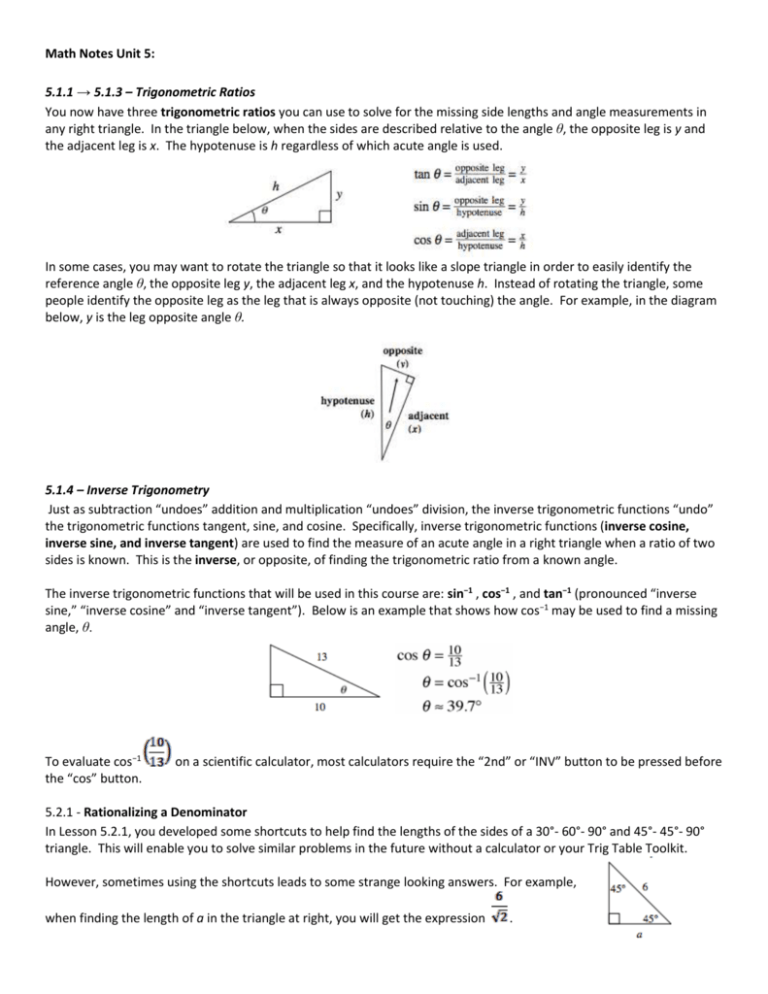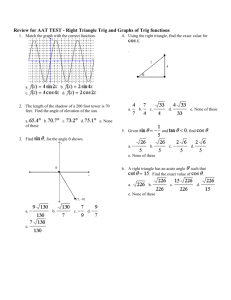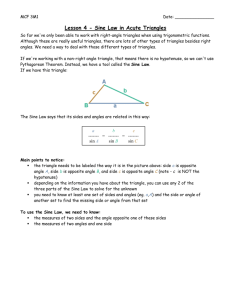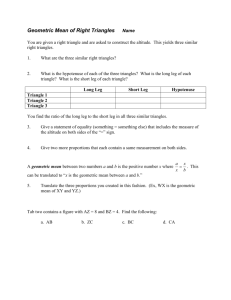Math Notes Unit 5:
advertisement

Math Notes Unit 5: 5.1.1 → 5.1.3 – Trigonometric Ratios You now have three trigonometric ratios you can use to solve for the missing side lengths and angle measurements in any right triangle. In the triangle below, when the sides are described relative to the angle θ, the opposite leg is y and the adjacent leg is x. The hypotenuse is h regardless of which acute angle is used. In some cases, you may want to rotate the triangle so that it looks like a slope triangle in order to easily identify the reference angle θ, the opposite leg y, the adjacent leg x, and the hypotenuse h. Instead of rotating the triangle, some people identify the opposite leg as the leg that is always opposite (not touching) the angle. For example, in the diagram below, y is the leg opposite angle θ. 5.1.4 – Inverse Trigonometry Just as subtraction “undoes” addition and multiplication “undoes” division, the inverse trigonometric functions “undo” the trigonometric functions tangent, sine, and cosine. Specifically, inverse trigonometric functions (inverse cosine, inverse sine, and inverse tangent) are used to find the measure of an acute angle in a right triangle when a ratio of two sides is known. This is the inverse, or opposite, of finding the trigonometric ratio from a known angle. The inverse trigonometric functions that will be used in this course are: sin−1 , cos−1 , and tan−1 (pronounced “inverse sine,” “inverse cosine” and “inverse tangent”). Below is an example that shows how cos−1 may be used to find a missing angle, θ. To evaluate cos−1 the “cos” button. on a scientific calculator, most calculators require the “2nd” or “INV” button to be pressed before 5.2.1 - Rationalizing a Denominator In Lesson 5.2.1, you developed some shortcuts to help find the lengths of the sides of a 30°- 60°- 90° and 45°- 45°- 90° triangle. This will enable you to solve similar problems in the future without a calculator or your Trig Table Toolkit. However, sometimes using the shortcuts leads to some strange looking answers. For example, when finding the length of a in the triangle at right, you will get the expression . A number with a radical in the denominator is difficult to estimate. Therefore, it is sometimes beneficial to rationalize the denominator so that no radical remains in the denominator. Study the example below. Example: Simplify First, multiply the numerator and denominator by the radical in the denominator. Since value of the expression. , this does not change the After multiplying, notice that the denominator no long has a radical, since further simplified. Since 2 divides evenly into 6, the expression . Often, the product can be can be rewritten as . 5.2.2 - Expected Value The amount you would expect to win (or lose) per game after playing a game of chance many times is called the expected value. This value does not need to be a possible outcome of a single game, but instead reflects an average amount that will be won or lost per game. For example, the “$9” portion of the spinner at right makes up of the spinner, while the “$4” portion is the rest, or , of the spinner. If the spinner was spun 12 times, probability predicts that it would land on “$9” once and “$4” eleven times. Therefore, someone spinning 12 times would expect to receive 1($9) + 11($4) = $53. On average, each spin would earn an expected value of ≈ $4.42. You could use this value to predict the result for any number of spins. For example, if you play 30 times, you would expect to win 30($4.42) = $132.50. Another way to calculate expected value involves the probability of each possible outcome. Since “$9” is expected of the time, and “$4” is expected expression ($9)( ) + ($4) + ( )= of the time, then the expected value can be calculated with the ≈ $4.42. A fair game is one in which the expected value is zero. Neither player expects to win or lose if the game is played numerous times. 5.3.1 - Special Right Triangles So far in this chapter, you have learned about several special right triangles. Being able to recognize these triangles will enable you to quickly find the lengths of the sides and will save you time and effort in the future. The half-equilateral triangle is also known as the 30°- 60°- 90° triangle. The sides of this triangle are always in the ratio , as shown below. Hypotenuse = 2 ∙ Short Leg Long Leg = Short Leg ∙ Another special triangle is the 45°- 45°- 90° triangle. This triangle is also commonly known as an isosceles right triangle. The ratio of the sides of this triangle is always . Hypotenuse = 2 ∙ Leg You also discovered several Pythagorean Triples. A Pythagorean Triple is any set of 3 positive integers a, b, and c for which a2 +b2 = c2 . Two of the common Pythagorean Triples that you will see throughout this course are shown below. 5.3.2 - Law of Sines For any ΔABC , the ratio of the sine of an angle to the length of the side opposite the angle is constant. This means that: This property is called the Law of Sines. This is a powerful tool because you can use the sine ratio to solve for measures of angles and lengths of sides of any triangle, not just right triangles. The law works for angle measures between 0° and 180°. 5.3.3 - Law of Cosines Just like the Law of Sines, the Law of Cosines represents a relationship between the sides and angles of a triangle. Specifically, when given the lengths of any two sides, such as a and b, and the angle between them, ∠C, the length of the third side, in this case c, can be found using this relationship: c 2 = a2 + b2 − 2abcosC Similar equations can be used to solve for a and b. a2 = b2+c2 – 2bccosA b2 = a2+c2 – 2accosB







